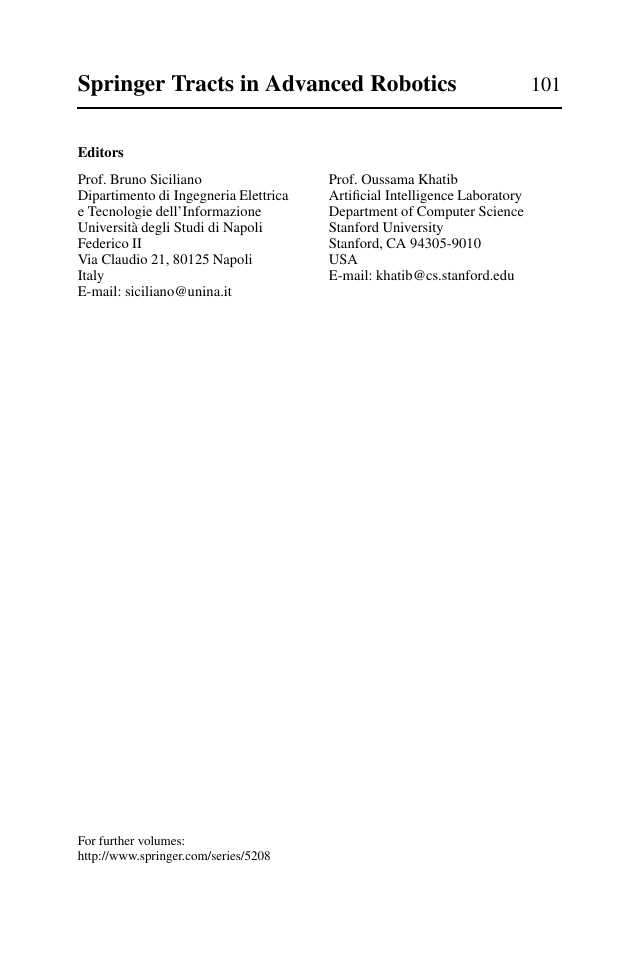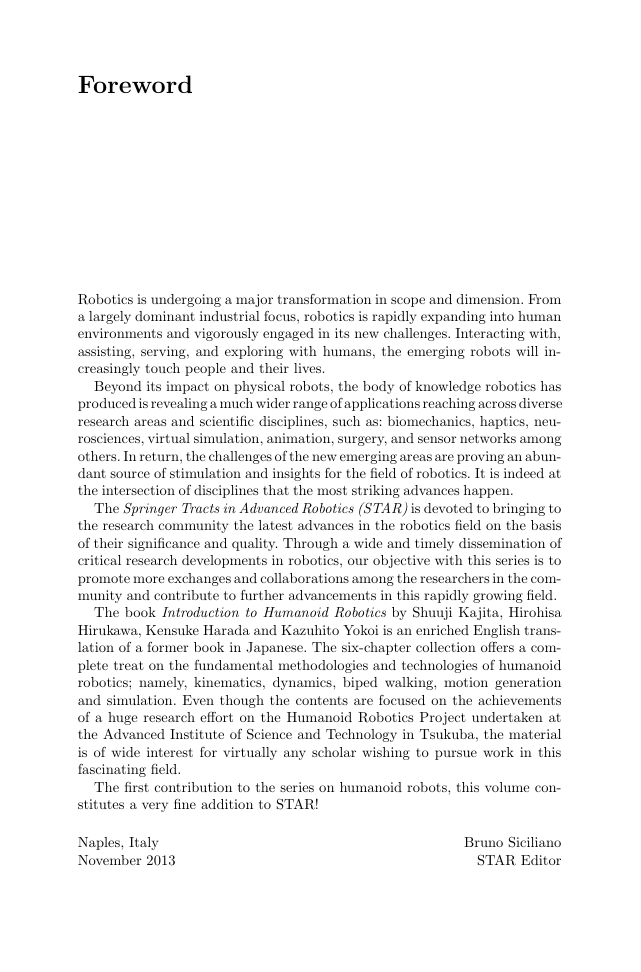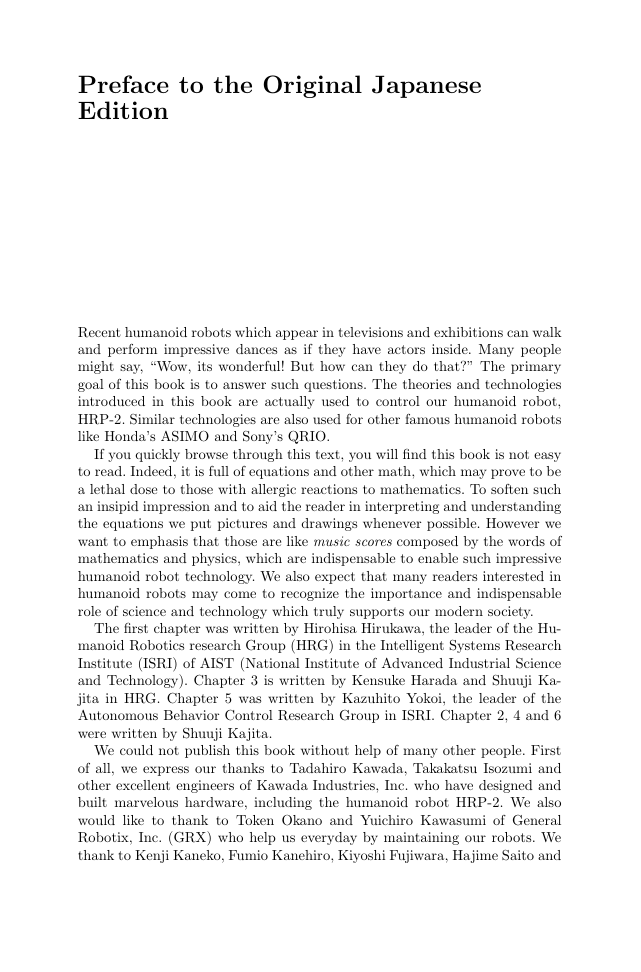Foreword
Preface to English Edition
Preface to the Original JapaneseEdition
Contents
Introduction
Kinematics
2.1
Coordinate Transformations
2.1.1
World Coordinates
2.1.2
Local Coordinates and Homogeneous Transformations
2.1.3
Local Coordinate Systems Local to Local Coordinate Systems
2.1.4
Homogeneous Transformations and Chain Rules
2.2
Characteristics of Rotational Motion
2.2.1
Roll, Pitch and Yaw Notation
2.2.2
The Meaning of Rotation Matrices
2.2.3
Calculating the Inverse of a Rotation Matrix
2.2.4
Angular Velocity Vector
2.2.5
Differentiation of the Rotation Matrix and Angular Velocity Vectors
2.2.6
Integration of the Angular Velocity Vector and Matrix Exponential
2.2.7
Matrix Logarithm
2.3
Velocity in Three Dimensional Space
2.3.1 The Linear and Angular Velocity of a Single Object
2.3.2
The Linear and Angular Velocity of Two Objects
2.4
Robot Data Structure and Programming
2.4.1
Data Structure
2.4.2
Programming with Recursions
2.5
Kinematics of a Humanoid Robot
2.5.1
Creating the Model
2.5.2 Forward Kinematics: Calculating the Position of the Links from Joint Angles
2.5.3
Inverse Kinematics: Calculating the Joint Angles from a Link's Position and Attitude
2.5.4
Numerical Solution to Inverse Kinematics
2.5.5
Jacobian
2.5.6
Jacobian and the Joint Velocity
2.5.7
Singular Postures
2.5.8
Inverse Kinematics with Singularity Robustness
2.5.9
Appendix: Supplementary Functions
ZMP and Dynamics
3.1
ZMP and Ground Reaction Forces
3.1.1
ZMP Overview
3.1.2
2D Analysis
3.1.3
3D Analysis
3.2
Measurement of ZMP
3.2.1
General Discussion
3.2.2
ZMP of Each Foot
3.2.3
ZMP for Both Feet Contact
3.3
Dynamics of Humanoid Robots
3.3.1
Humanoid Robot Motion and Ground Reaction Force
3.3.2
Momentum
3.3.3
Angular Momentum
3.3.4
Angular Momentum and Inertia Tensor of Rigid Body
3.3.5
Calculation of Robot's Center of Mass
3.5.6
Calculation of Link Speed and Angular Velocity
3.5.7
Calculation of Robot's Momentum
3.3.8
Calculation of Robot's Angular Momentum
3.4
Calculation of ZMP from Robot's Motion
3.4.1 Derivation of ZMP
3.4.2
Calculation of ZMP Using Approximation
3.5
Some Notes for ZMP
3.5.1
Two Explanations
3.5.2
Does ZMP Exist Outside the Support Polygon due to the Acceleration of the Center of Mass?
3.5.3
Limitation of ZMP
3.6
Appendix: Convex Set and Convex Hull
Biped Walking
4.1
How to Realize Biped Walking?
4.2
Two Dimensional Walking Pattern Generation
4.2.1
Two Dimensional Inverted Pendulum
4.2.2
Behavior of Linear Inverted Pendulum
4.2.3
Orbital Energy
4.2.4
Support Leg Exchange
4.2.5
Planning a Simple Biped Gait
4.2.6
Extension to a Walk on Uneven Terrain
4.3
3D Walking Pattern Generation
4.3.1
3D Linear Inverted Pendulum
4.3.2
Natures of the 3D Linear Inverted Pendulum
4.3.3
3D Walking Pattern Generation
4.3.4
Introducing Double Support Phase
4.3.5
From Linear Inverted Pendulum to Multi-body Model
4.3.6
Implementation Example
4.4
ZMP Based Walking Pattern Generation
4.4.1
Cart-Table Model
4.4.2
Off-Line Walking Pattern Generation
4.4.3
On-Line Walking Pattern Generation
4.4.4
Dynamics Filter Based on Preview Control
4.4.5
Advanced Pattern Generators
4.5
Stabilizer
4.5.1
Principles of Stabilizing Control
4.5.2
Stabilizing Control of Honda Humanoid Robot
4.5.3
Advanced Stabilizers
4.6
Pioneers of Dynamic Biped Walking Technology
4.7
Additional Methods for Biped Control
4.7.1
Passive Dynamic Walk
4.7.2
Nonlinear Oscillator and Central Pattern Generators
4.7.3
Learning and Evolutionary Computing
Generation of Whole Body Motion Patterns
5.1
How to Generate Whole Body Motion
5.2
Generating Rough Whole Body Motion
5.2.1
Using Motion Capture
5.2.2
Using a Graphical User Interface
5.2.3
Using High Speed Multivariate Search Methods
5.3
Converting Whole Body Motion Patterns to Dynamically Stable Motion
5.3.1
Dynamics Filter
5.3.2
Auto Balancer
5.3.3
Strict Trunk Motion Computation Algorithm
5.4
Remote Operation of Humanoid Robots with Whole Body Motion Generation
5.4.1
Remote Generation of Whole Body Motion Using the Operation Point Switching Method
5.4.2
Full Body Motion Generation of Stable Motion Using Split Momentum Control
5.4.3
Application and Experiments with the Humanoid Robot HRP-2
5.5
Reducing the Impact of a Humanoid Robot Falling Backwards
5.6
Making a Humanoid Robot Get Up Again
Dynamic Simulation
6.1
Dynamics of Rotating Rigid Body
6.1.1
Euler's Equation of Motion
6.1.2
Simulation of Rigid Body Rotation
6.2 Spatial Velocity
6.2.1
Speed of Rigid Body
6.2.2
Integration of Spatial Velocity
6.3
Dynamics of Rigid Body
6.3.1
Newton-Euler Equations
6.3.2
Dynamics by Spatial Velocity
6.3.3
Rigid Body Simulation Based on Spatial Velocity
6.3.4
Simulation of a Spinning Top
6.4
Dynamics of Link System
6.4.1
Forward Kinematics with Acceleration
6.4.2
Inverse Dynamics of Link System
6.4.3
Forward Dynamics of Link System
6.4.4
Featherstone's Method
6.5
Background Material for This Section
6.6
Appendix
6.6.1
Treatment of Force and Moment
6.6.2
Subroutines
References
Index
















 2023年江西萍乡中考道德与法治真题及答案.doc
2023年江西萍乡中考道德与法治真题及答案.doc 2012年重庆南川中考生物真题及答案.doc
2012年重庆南川中考生物真题及答案.doc 2013年江西师范大学地理学综合及文艺理论基础考研真题.doc
2013年江西师范大学地理学综合及文艺理论基础考研真题.doc 2020年四川甘孜小升初语文真题及答案I卷.doc
2020年四川甘孜小升初语文真题及答案I卷.doc 2020年注册岩土工程师专业基础考试真题及答案.doc
2020年注册岩土工程师专业基础考试真题及答案.doc 2023-2024学年福建省厦门市九年级上学期数学月考试题及答案.doc
2023-2024学年福建省厦门市九年级上学期数学月考试题及答案.doc 2021-2022学年辽宁省沈阳市大东区九年级上学期语文期末试题及答案.doc
2021-2022学年辽宁省沈阳市大东区九年级上学期语文期末试题及答案.doc 2022-2023学年北京东城区初三第一学期物理期末试卷及答案.doc
2022-2023学年北京东城区初三第一学期物理期末试卷及答案.doc 2018上半年江西教师资格初中地理学科知识与教学能力真题及答案.doc
2018上半年江西教师资格初中地理学科知识与教学能力真题及答案.doc 2012年河北国家公务员申论考试真题及答案-省级.doc
2012年河北国家公务员申论考试真题及答案-省级.doc 2020-2021学年江苏省扬州市江都区邵樊片九年级上学期数学第一次质量检测试题及答案.doc
2020-2021学年江苏省扬州市江都区邵樊片九年级上学期数学第一次质量检测试题及答案.doc 2022下半年黑龙江教师资格证中学综合素质真题及答案.doc
2022下半年黑龙江教师资格证中学综合素质真题及答案.doc